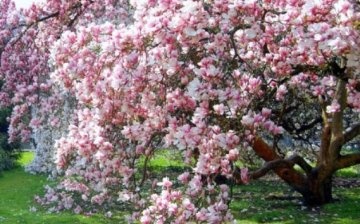Magnolia plant - the charm of delicate flowering
Delicate magnolia flowers conquer with their originality and harmony. The magnolia plant belongs to the oldest magnolia family, with over 70 species.
Magnolia is a large evergreen tree with a dense, wide-pyramidal crown, reaching a height of 15 meters. The leaves are large, simple, oval, leathery; the upper side is dark green, glabrous, shiny, the lower side is covered with rusty pubescence. Each leaf does not live long, as the young leaves grow, the old ones fall off. Fragrant flowers are very effective - large, cupped, located singly at the ends of the branches. Magnolia blooms in spring and summer, forming a fruit that resembles a conifer cone.
The magnolia plant is not difficult to grow, however, certain agricultural rules must be observed. Magnolia does not like calcareous and salty soils, but loves moisture very much, which should not be forgotten, as well as mulching and protection from the wind. If the tops freeze, pruning should be done, the branches will recover in the same season.
Magnolia is propagated by seeds, layering and grafting, some species and cuttings. The tree feels great in slightly shaded and sunny places, well protected from the wind. The soil he needs is loose, fertile, evenly moistened with good drainage, and it does not matter if it is alkaline, acidic or neutral. Regular feeding of magnolias is recommended.
In addition to the beauty that leaves no one indifferent, the plant also has medicinal properties. Products containing magnolia leaves help reduce blood pressure, reduce heart rate and relieve pain in the heart.




Magnolia is truly mesmerizing, you can't take your eyes off! When we rested in the south last year, almost all the photos were against the background of blooming magnolia :)